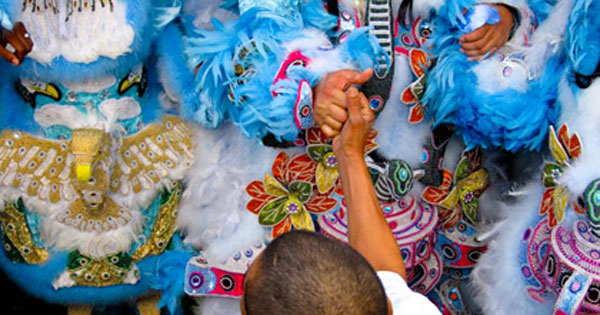
Even a partially sentient first-time visitor coming upon a Mardi Gras Indian will have a long list of questions. The inevitable first question, though, can always be answered with: “No, they’re not Native American.” This is a purely African-American tradition. Starting in the 1880s, various neighborhoods formed tribes. A big chief and his tribal members, sometimes including a queen, would “mask” as Great Plains Indians, donning extravagant beaded suits and feathered headdresses. (Today, some suits are nearly 10 feet tall and half as wide.) They would drum and parade and chant and, periodically, fight.
The history behind the suits is murky and contentious. Some suggest it was a way of honoring Native Americans who sheltered runaway slaves, and also a means of paying respect to a culture that fiercely resisted European domination. Others say it arose after Buffalo Bill’s Wild West Show passed through New Orleans in 1884. (Lending some credibility to the latter theory: the first documented tribe called itself the Creole Wild West.) It’s likely a combination of all these things and then some.
Tribal members at one time carried real hatchets and knives, and bloody gang-style skirmishes broke out. In recent years lethal fights have been replaced by mock battles and other sacraments. The competition is now primarily aesthetic—a battle over who can sew the prettiest suit. There’s no judging panel and no winner; respect is awarded in individual encounters chief by chief, through quiet nods and murmurs of admiration.
Hard and fast rules appear to be scarce within Mardi Gras Indian culture, with one exception: no one wears the same suit twice. There’s tremendous pride in the crafting—especially in the intricate hand-sewn beadwork, with some panels the size of sports bar televisions. The work is never jobbed out, and sewing machines are frowned upon. Each year’s suit is broken up or stashed away at the end of the season, so every year the tribal members gather in dens and living rooms and kitchens to sew beads, stitch feathers, and tell stories, often starting just days after the old suit is retired. I’ve been told the cost of a suit can run anywhere from $5,000 to $30,000.
The new suits almost always get their first public display on Mardi Gras day. But that’s a day of considerable distraction, so several times each spring the Indians again suit up and take to the streets. Uptown Super Sunday, which occurred this past weekend, is the day when a couple dozen tribes converge on a Central City neighborhood amid drumming, war cries, and the inescapable aroma of grilled meat from sidewalk vendors. But the elaborate suits are the heart of the matter. It’s as if dozens of Hollywood movies premiered at once, with each suit containing its own characters and narrative.
“Modernity protects certain lines of history but not others,” wrote Jay Griffiths in her 1999 book, A Sideways Look at Time. She noted that “artifact history” often lends itself to being commodified and thus gets preserved, whereas “ritual history” is harder to convert into a commodity, and is more liable to be lost. Griffiths quotes “Arthur Pendragon,” the oft-arrested neo-Druid leader of rituals at Stonehenge: “We should protect traditions and the root emotions behind them. These are important, not the artifacts.”
When I lived in New England I was surrounded by several centuries of American history, which invariably took the form of artifacts. Local history museums overflowed with quilts, lumberjack tools, clam hods, apothecary jars, and other inert objects awaiting animation by a docent. Community rituals, where they existed, tended to be orchestrated by community boosters to encourage tourism.
In New Orleans, I’ve found surprisingly little artifact history, maybe because of the termites and rot, or maybe the frequent hurricanes have periodically cleaned out all the closets. Yet, no American city is as dense with extraordinary rituals that take place unencumbered by arts administrators and grant guidelines.
On the street, the Indians in their suits are usually accompanied by drumming that’s been linked historically to Africa and Afro-Caribbean islands. You hear the persistent call-and-response chants, echoes of an enslaved American South. Conflicts are worked out and messages sent, although much of that is opaque to outsiders like me. “The Mardi Gras Indians of New Orleans offer an important illustration of the persistence of popular narratives in the modern world,” wrote American studies scholar George Lipsitz in 1988. “The Mardi Gras Indian narrative takes many forms, but its central theme is the story of heroic warriors resisting domination.” “Won’t bow down,” goes a common refrain. “Don’t know how.”
Another March event in which Indians put on their suits occurs tonight, St. Joseph’s night, when tribes emerge in the murky darkness of the flood-dimmed Central City neighborhood. The chiefs determine the route of the wanderings as evening passes into night, and you’re never quite sure where they’ll show up.
I’ll head out around dark and listen for the drums, then move in that direction. At some point I anticipate I’ll be looking up an empty and dark street when a sudden small explosion of color (orange or purple or electric green) will erupt as a “spy boy”—whose job it is to locate opposing chiefs—emerges under a streetlight a block or two away. He’ll issue a keening cry that seems at once familiar yet indecipherable, as if emanating from some place centuries deep.
It’s not quite a full-blown spectacle, but certainly not everyday life. Think of it as peering over the edge of a cliff, and having your breath taken away by the sheer depths of a chasm you didn’t even know existed.


